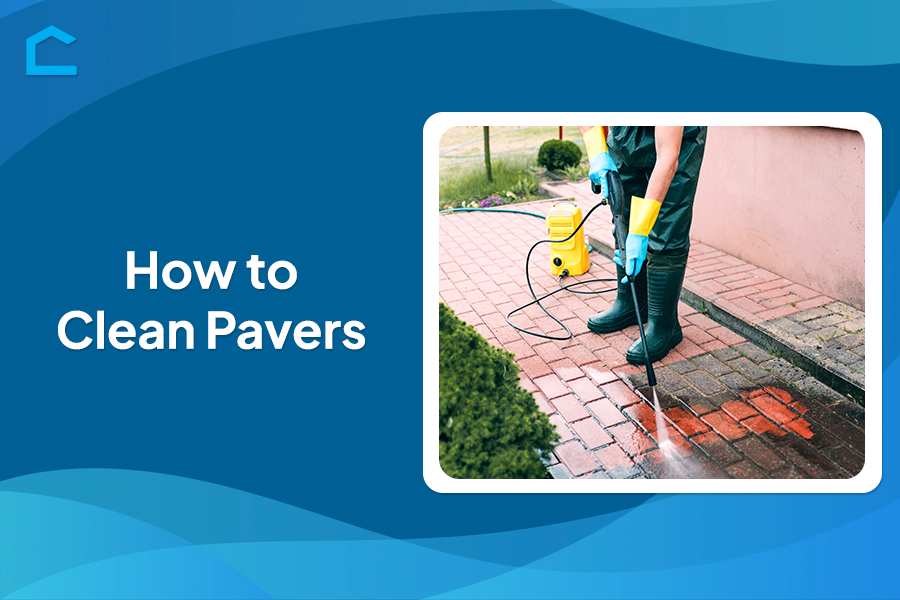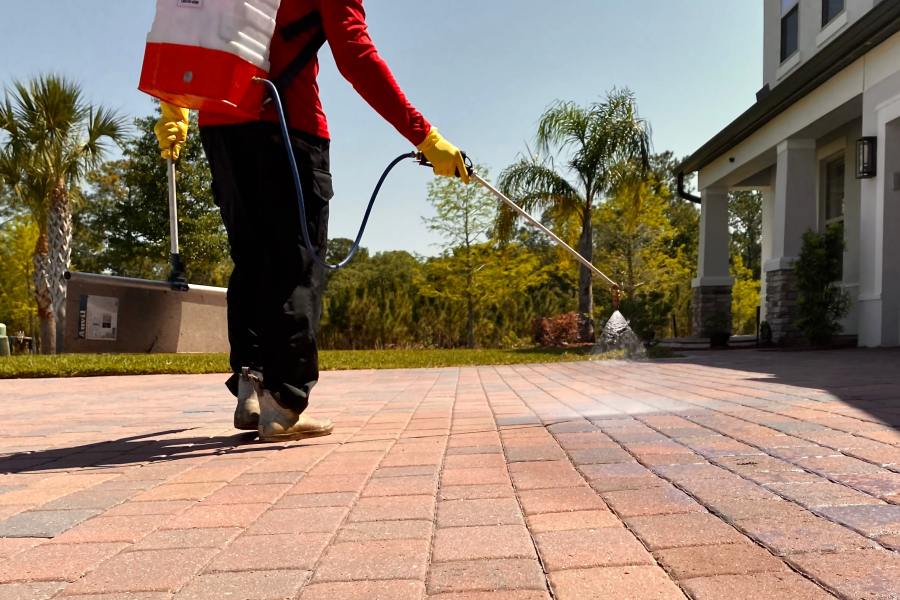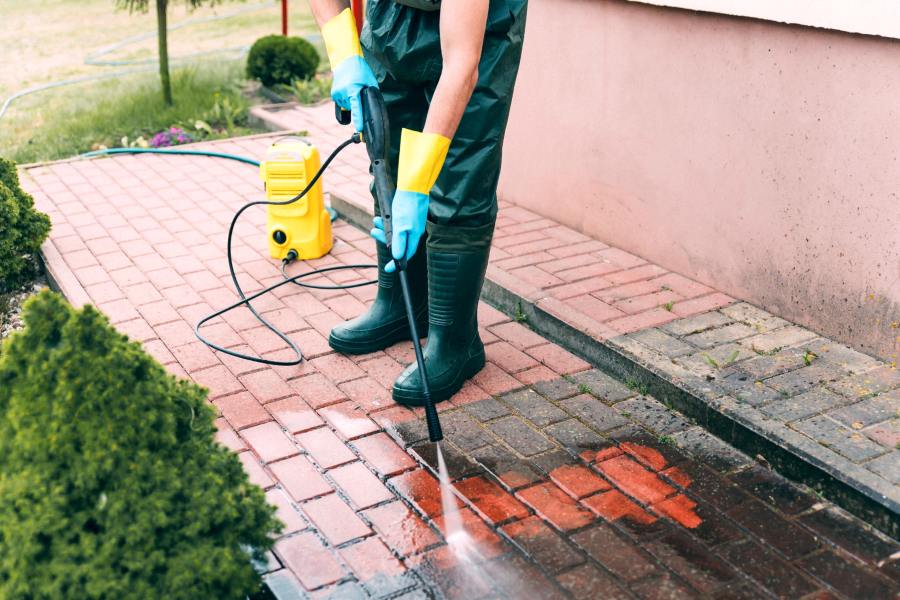How to Clean Pavers

The timeless appeal of paver patios, driveways, and walkways can transform any outdoor space into a stunning landscape feature. Yet, like any exterior element exposed to the elements, pavers face a constant battle against nature’s persistent forces.
From stubborn moss and persistent weeds to unsightly stains and weathering, these durable stones require proper maintenance to retain their original charm. Many homeowners invest thousands in installing beautiful paver surfaces, only to watch them slowly lose their luster under layers of dirt, organic growth, and environmental debris.
This leaves many wondering about how to clean pavers to protect their natural beauty. The good news is that with the right approach and regular upkeep, pavers can maintain their aesthetic appeal and structural integrity for decades.

How to Clean Pavers
Paving, which uses materials like concrete, stone, or brick to create durable outdoor surfaces, is the foundation of walkways, patios, and driveways and requires proper cleaning.
Begin by removing all furniture, potted plants, and decorative items from your paver surface. Clear away any loose debris, fallen leaves, and visible dirt using a leaf blower or sturdy broom. Pay special attention to the joints between pavers where organic matter tends to accumulate.
After sweeping the dirt out of the pavers, use a pressure washer on a low setting or a garden hose with a spray nozzle to give the pavers an initial rinse. This preliminary cleaning helps reveal any stubborn stains or problem areas that might require extra attention during the main cleaning process. Consider using a weed killer several days before cleaning if vegetation grows between pavers.
Inspect the entire paver surface for loose or damaged pieces that may need repair or replacement. Check joint sand levels between pavers and note areas where additional sand might be needed after cleaning. Make sure to keep the plants away from the cleaning solutions. If you are not a fan of the chemicals, choose an environmentally friendly cleaning solution to protect yourself and the nearby plants or grass.
Choosing the Right Cleaning Solution
For general cleaning, a mixture of mild dish soap and warm water often proves effective for the cleaning of most paver types. However, concrete pavers might require a specialized alkaline cleaner, while natural stone pavers may need pH-neutral solutions to prevent damage to their surface composition.
Test your chosen cleaning solution on a small, inconspicuous area to ensure it won’t cause discoloration or damage. For heavily soiled areas, consider commercial paver cleaners specifically formulated for your paver material, as these products are designed to tackle tough dirt while protecting the surface.
Consider environmental factors and local regulations when selecting cleaning products. Look for eco-friendly options that won’t harm surrounding vegetation or contaminate groundwater. Always read manufacturer guidelines for proper dilution ratios and application methods specific to your paver type.
Cleaning the Pavers
Apply your chosen cleaning solution generously across the paver surface using a garden sprayer or large brush. Allow the solution to sit for 10-15 minutes, but don’t let it dry completely, as this can leave residue marks on the surface.
Regular cleaning like this can help extend the lifespan of pavers, which can last 25 to 50 years when properly maintained, by preserving their color and preventing wear.
Work in manageable sections, scrubbing the surface with a stiff-bristled brush using circular motions. Pay extra attention to heavily trafficked areas and spots with visible staining. Rinse thoroughly with clean water after scrubbing each section to prevent cleaning solution residue from drying on the pavers.
After the initial cleaning, inspect the surface for any missed spots or persistent stains. Re-apply the cleaning solution to these areas if necessary, and consider using a scrub brush with softer bristles for delicate or textured pavers. Ensure the remaining cleaning solution is completely rinsed away to prevent any residual film formation.
Removing Tough Stains
For oil and grease stains, apply a specialized degreaser or poultice directly to the affected area. Cover with plastic wrap and allow it to sit for 24 hours, letting the cleaner draw out deep-set stains from the paver’s porous surface.
Attack moss and algae with a mixture of water and oxygen bleach, letting it sit for 15 minutes before scrubbing. For rust stains, use a commercial rust remover designed for your specific paver type, following the manufacturer’s instructions carefully to avoid damage.
For paint or adhesive residue, use appropriate solvents or commercial paint strippers designed for outdoor use. Work carefully with metal scrapers to avoid scratching the paver surface, and always test stain removal products in an inconspicuous area first.
Sealing Pavers After Cleaning
Wait for pavers to dry completely, typically 24-48 hours, before applying a quality paver sealer. Choose between penetrating sealers for a natural look or topical sealers for a glossy finish, considering your local climate and the paver’s exposure to elements.
Apply the sealer evenly using a roller or sprayer, working in small sections to ensure complete coverage. Most pavers require two coats of sealer, with adequate drying time between applications. This protective barrier will help repel stains, prevent weed growth, and maintain the pavers’ color vibrancy for years to come.
Monitor weather conditions before and after sealing, as temperature and humidity can affect the sealing process. Avoid applying sealer if rain is forecasted within 24 hours, and keep foot traffic off the sealed surface for at least 24 hours after the final coat.
How to Remove Moss From Paving Stones
To remove moss from paving stones naturally, start by sweeping away loose debris and moss with a stiff brush. Create an eco-friendly cleaning solution using either white vinegar diluted with equal parts water or a paste made from baking soda and water.
Apply your chosen solution generously to the affected areas and let it sit for 15-20 minutes. For a completely natural approach, pour boiling water directly onto mossy areas, as the heat effectively kills the growth.
After treatment, scrub the loosened moss away using a wire brush in circular motions. Prevent future growth by improving drainage and reducing shade from overhanging branches. Apply a monthly preventive spray made from steeped chamomile tea and tea tree oil.
How to Remove Oil From Paving
To effectively remove oil stains from paving, act quickly on fresh spills by covering them with absorbent materials like cat litter, baking soda, or cornstarch for 24 hours. Driveways, which often feature popular paving ideas like patterned concrete or natural stone, are particularly prone to oil stains from parked cars.
For stubborn stains, apply a paste made from baking soda and water, cover with plastic wrap, and leave overnight.
Commercial degreasers or trisodium phosphate (TSP) solutions can tackle set-in stains. Apply the cleaner, let it sit for 15-20 minutes, then scrub vigorously with a stiff-bristled brush using circular motions.
A pressure washer can help force out deeply embedded oil, but start with low pressure to avoid damage. After cleaning, consider applying a penetrating sealer to prevent future stains, and use drip pans under vehicles to protect your pavement.

How to Remove Dried Cement From Paving Slabs
To remove dried cement from paving slabs, start by gathering safety equipment, including goggles, heavy-duty gloves, and a dust mask. Begin with mechanical removal using a plastic scraper or wooden tool to clear loose cement. Then carefully use a hammer and chisel at a shallow angle for thicker deposits.
Apply a specialized cement dissolver or diluted muriatic acid solution to the remaining residue, letting it sit for 15-20 minutes while keeping the area damp through occasional misting.
Scrub the softened cement with a stiff brush in circular motions, then rinse thoroughly with clean water. For acid-based cleaners, neutralize with a baking soda solution afterwards. Once complete, allow the surface to dry and consider applying a sealer for future protection.
Conclusion
We hope this comprehensive guide on how to clean pavers has equipped you with the knowledge and confidence to maintain your outdoor surfaces effectively. Remember that regular maintenance and prompt attention to stains can significantly reduce the effort required for deep cleaning sessions.
Whether you’re dealing with stubborn oil stains, persistent moss, or dried cement, the key lies in using the right techniques and appropriate cleaning solutions for your specific paver type.
By following these methods and incorporating preventive measures like sealing, you can extend the beauty and life of your pavers for years to come. With proper care and maintenance, your paved surfaces will continue to enhance your property’s aesthetic appeal while maintaining their durability and functionality.
